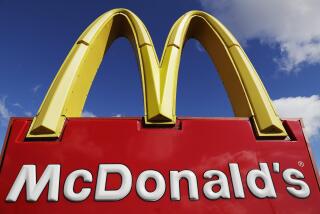COLUMN ONE : The Lure of the Super Deal : A bargain once meant trading quality for price. Today, we look at quality <i> and</i> price. Marketers have responded with discount wars and ‘value-added’ products. And now K mart accepts American Express.
- Share via
There was no advertised sale. No specials. No markdowns.
But when Watts Wacker waltzed into the Macy’s store in Manhattan to buy some name-brand men’s underwear, he demanded 10% off the price tag.
Nothing was wrong with the briefs. But Wacker, a consumer-minded futurist at the consulting firm Yankelovich & Partners, just wanted to see what would happen if he refused to pay full price.
The department manager was summoned. Wacker declared what he was willing to pay, then threatened to take his business elsewhere if that price was not met. With no further discussion, Wacker got the deal he wanted.
“Consumers have come to learn that the only real price is the discount price,” Wacker said.
Like most consumers, Wacker was looking for the best value for his money. But value in the 1990s is something very different from what it was in the 1960s, 1970s and 1980s--particularly for Southern California consumers stuck in a long economic downturn.
People don’t just want the cheapest product anymore. In fact, consumers today are often reluctant to trust the lowest-priced product. What consumers want most is to feel as if they have gotten a super deal. They want to be considered smart shoppers.
Today, that means getting the highest-quality merchandise at the best price--whether that takes the consumer to Neiman Marcus or Price Club. When American Express recently asked its cardholders where they most wanted to be able to use their cards, it was surprised to find K mart and Sears atop the list. Indeed, K mart began accepting American Express this spring. A recent Gallup poll found that more than half of those surveyed nationwide said they shop at discount stores and conventional department stores.
“Value is the perception that consumers have of themselves when they leave the store,” said Bruce Silverman, president of the Los Angeles-based advertising agency Asher/Gould. “But consumers don’t just want to feel smart, they also don’t want to feel dumb.”
A number of marketers have successfully zeroed in on this consumer quest for “smart” value.
Lexus is selling its top-end $47,000 cars by positioning them as good values--just as Nissan is selling its $15,000 Altimas by persuading consumers that they essentially get a luxury car for the price of a conventional sedan.
Consumer demand for better value has forced even reluctant marketers to react.
It was consumer attraction to no-name cigarettes that forced Philip Morris to lower the price of its Marlboro brand 40 cents per pack. McDonald’s started promoting its “Value Meals” only after consumers lit up to rival Taco Bell’s low-price menu. Consumer response to low-cost airlines such as Southwest has forced other major carriers to adopt discount fares on competing routes.
“What you have today are consumers who are holding manufacturers and retailers hostage,” said Michael W. Marsak, president of Effective Marketing Strategies, a Marina del Rey-based retail consulting firm.
Consumers’ shopping patterns also are changing. In apparel sales, the market share held by warehouse clubs and off-price outlets more than doubled to a record 22.5% in 1992, compared to 10.5% in 1980, according to a recent survey by NPD Group, a Port Washington, N.Y., research firm.
One Las Vegas consumer recently approached by a market researcher described her vision of the perfect mall: “It would have Nordstrom at one end and Wal-Mart at the other.”
Value shopping also means knowing when not to shop.
“Today’s consumer is a sale animal,” Marsak said. “The trick is to buy only what’s on sale--or just wait a week or two for the next sale.”
Who is behind this infatuation with value?
“It’s certainly not the people who are making the products,” said Jim Hillison, senior vice president at the Beverly Hills-based research firm Phase One. “This is all being dictated by the consumer.”
Value-driven consumers are spending more time shopping--and making more stops. This reverses a trend that lasted from 1985 until 1990, when consumers spent less and less time shopping, said Jody Martin, vice president of marketing at the Indianapolis-based research firm Stillerman Jones & Co. Starting in 1991, shoppers concerned with saving money began to slightly lengthen their trips to the store, she said.
“It’s not that people suddenly have more time to shop,” Martin said. “People are going anywhere for the best values.”
Society’s definition of value has changed vastly over the past four decades. In the 1950s and 1960s, most consumers assumed that the more they paid for products, the more valuable these products were, Wacker said. By the 1970s, consumers were not just looking at price, but also at quality.
Then, in the 1980s, overworked consumers began to consider other issues--such as time and convenience.
Now, in the 1990s, the sluggish economy has required more belt-tightening. And Wacker says yet another factor has become part of the value equation: Stress.
Consumers are finding value by conserving mental and physical energy. That can mean a consumer preference for quick, easy stops at several strip centers instead of one lengthy trip to a giant, crowded shopping mall.
“People are willing to add more stops to their shopping trip if they are convinced that, in the end, the overall experience of getting what they want will be emotionally easier,” Wacker said.
Some unlikely shopping centers are trying to appeal to this new, value-conscious consumer.
Among them: Fashion Island in Newport Beach, one of the country’s most upscale malls. Late last year, it opened a huge Circuit City home electronics store.
Never mind that the typical Fashion Island shopper has an annual household income exceeding $70,000. “This store meets the needs of our customers,” said Rick Evans, president of the Irvine Retail Co., a division of the Irvine Co., which owns Fashion Island.
Shopping for value has become an integral part of the American consumer’s psyche. It’s almost as if people subconsciously grade themselves each time they return from the store, Wacker said. “People feel wholly inadequate today if they spend money in a bad way.”
But the term value is being tossed around so much in regional and national advertising that it may eventually lose its consumer appeal.
“Everyone has jumped on the value bandwagon,” said Brad A. Ball, president of the Los Angeles ad agency Davis, Ball & Colombatto. “It reminds me of that health kick a few years ago when everybody bragged about putting bran in their food.”
For example, even as General Motors recently boosted 1994 model prices an average $290 on most passenger cars and $445 on trucks, it called these price hikes “value pricing.” When StarKist Foods recently started selling “Charlie’s Tuna Kit”--a combo that includes crackers and cheese--it heavily promoted the product as its first “value-added” tuna.
Some consumers have become so skeptical of advertisers’ claims of special value that they do not listen to the hyperbole.
“If the very notion of value doesn’t evolve pretty soon, we’ll all stop paying attention,” said Allison Cohen, president of PeopleTalk, a New York-based consulting firm.
Indeed, some experts are forecasting the demise of value as a marketing hook. “I give it another three years of shelf life,” said Valerie Folkes, a marketing professor at USC who said the concept is overused.
Still, marketers who have staked their reputations on the ‘90s rendition of value merchandising insist that value is here to stay. Key among them are two Japanese auto nameplates: Toyota’s Lexus and Nissan’s Altima.
Nissan saw its sales slip in the late 1980s and early ‘90s as it introduced a series of performance cars. Then the light bulb went on. Company executives realized “there are a lot more people looking for smart buys than fast cars,” said Earl Hesterberg, general manager of Nissan.
Nissan’s Venice-based ad agency, Chiat/Day, created a campaign that tagged Altima “the affordable luxury sedan.” Ads consistently compare the $15,000 automobile to prestige brands such as Lexus and Mercedes.
Clearly, the campaign has worked. Nissan had hoped to sell 100,000 Altimas this year, but projects it will sell more than 120,000.
Not every driver wants a $15,000 car, however. Lexus likes to compare its $30,000 vehicle, the Lexus ES 300, to Mercedes models that cost nearly twice that price.
“If you were to just define value on price, you wouldn’t be interested in a Lexus,” said George Borst, group vice president and general manager for Lexus.
Typical Lexus buyers add other things into the value equation--resale value, for example. In that arena, Lexus seems to be in its own class. A Lexus LS 400 purchased for $38,650 in 1990 has a current resale value of $29,389, according to the National Automotive Dealer Assn. handbook. A Mercedes 300E, purchased for $8,000 more that same year, today has a resale value less than the Lexus’.
To understand what its customers consider real value, Lexus--which prides itself on service--recently began listening to them even more closely.
Each of the 250 employees at the company’s U.S. headquarters in Torrance must make at least five phone calls a month to customers who recently took delivery of a Lexus. “I always ask them if they’re satisfied--and if not, why not,” Borst said. “This plugs us into what’s really going on in the consumer’s mind.”
Consumers also are searching for value in less expensive products ranging from clothes to beer.
Executives at the clothing chain Clothestime say this is particularly true in the beleaguered Southland. “If somebody else in Southern California is selling leggings for $10, then we have to sell ours for $8,” said John Ortega, the firm’s chairman and co-founder.
Some Clothestime stores are just beginning to test-market the chain’s own brand of women’s jeans, Best World Brand, which it sells for $21.99--about $10 below similar name-brand jeans sold at the Gap.
Few marketers, however, are hammering away at the value message like Pabst Brewing Co.
Executives at Pabst say that in the beer industry--much like the tobacco industry--value is fast replacing image. Its Pabst Blue Ribbon brand sells for about $1 less a six-pack than Miller or Budweiser.
“The trick is to convince consumers that just because you cost less, that doesn’t mean you taste cheap,” said Lutz Issleib, chairman of Pabst. Its ads directly compare the brew to Bud and Miller, playing off the market leaders’ slogans.
One print ad for Pabst mockingly asks: “Why is Bud so expensive? Why ask why?” Another has this to say about Miller: “It’s expensive. And that’s that.”
Pabst, which was the nation’s No. 2-selling beer in the 1950s, nearly disappeared from the shelf in the mid-1980s. Its sales are up 6.1% for the first six months of 1993, while most other brands are either flat or down.
Whether it is beer or clothing or cars, the way futurist Wacker figures it, consumers are going to keep demanding better value, no matter what happens to the economy.
“Once you become smart,” said Wacker, “you don’t become stupid overnight.”
More to Read
Inside the business of entertainment
The Wide Shot brings you news, analysis and insights on everything from streaming wars to production — and what it all means for the future.
You may occasionally receive promotional content from the Los Angeles Times.










